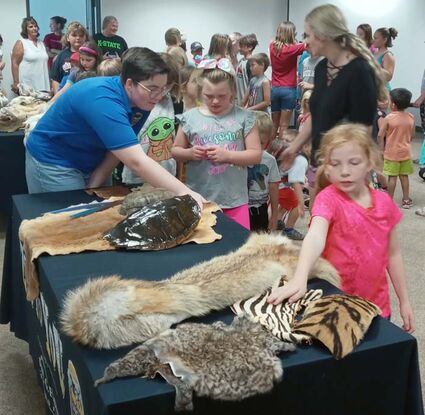Rolling Hills Zoo joins final session of "Tails and Tales"
August 5, 2021

Jessica Olp and Kodi Smith from Rolling Hills Zoo joined eager children Thursday morning at the Mankato City Library for the last presentation of the "Tails and Tales" summer reading program.
Final Summer Tales
Jessica Olp and Kodi Smith from Rolling Hills Zoo joined eager children Thursday morning at the Mankato City Library for the last presentation of the "Tails and Tales" summer reading program. Olp and Smith brought a bearded dragon named Beardy B, a ball python named Zeus, and a couple of African millipedes.
The topic of the program was adaptation. Olp gave two adages to help the attendees know the difference between predators and prey. "Eyes in the front are animals that hunt ... most of the time," is the statement often used to help decide if an animal is a predator. "Eyes on the side are animals that should hide," is how you can tell if an animal is usually prey.
During the presentation, Olp informed the children tigers are the largest of wild cats. Tigers are larger than lions even though the lions' claws are bigger. Fifty percent of a tiger's diet is wild pigs.
Olp told the children about disruptive camouflage, which zebras are known for. Disruptive camouflage allows the zebras to hide within their group, which is called a dazzle or a zeal. Expanding further on the topic of zebras, Olp told the children the only reason a female zebra will break away from the dazzle is to give birth. The reason for that is because she is teaching her foal her stripe pattern since no two zebras have the same stripe pattern. She is teaching her foal to know her scent so the foal can locate her in the dazzle, and she is also teaching the foal her sound.
Olp told about ostriches. She said even though an ostrich's kick is forceful enough to kick off a lion's head, an ostrich only uses that as a last resort. It is not true about ostriches hiding their heads in the sand. Olp said because of camouflaging, when an ostrich places its head on the sand, it blends in so well that it is not seen very well.
After talking about a few other animals, Olp and Smith brought out Beady B, the bearded dragon. Smith walked around the room, showing him to the children as Olp talked about the adaptations bearded dragons have. After the bearded dragon, the African millipedes were brought out and talked about. Zeus, the ball python, was the last animal shown.
Olp suggested to the children they ask their librarian for help in finding books about the animals that interest them. She told the youngsters if they were unable to find an answer to their questions, they could write a letter to her at the zoo and she would answer them.










Reader Comments(0)